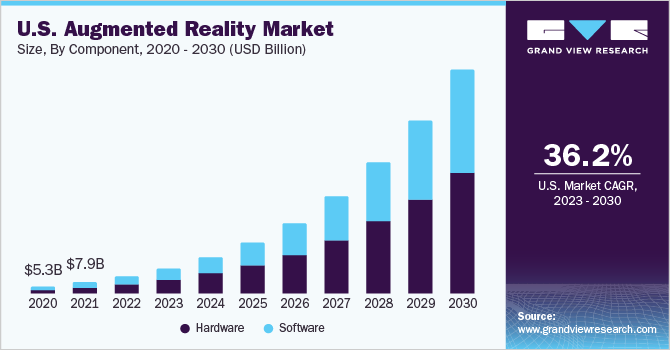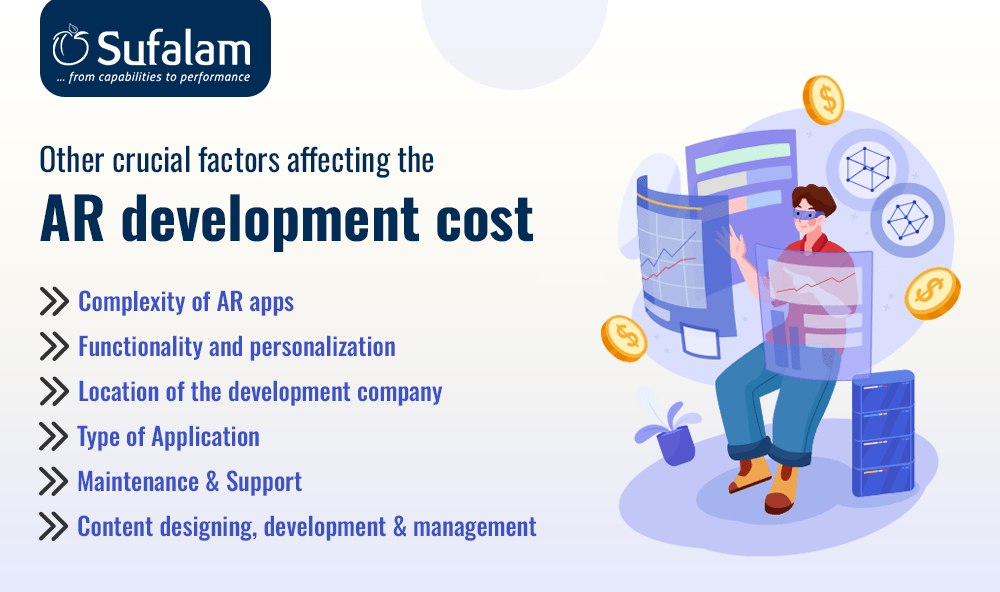
Among the most innovative technological advancements in recent times is augmented reality. According to Digi-Capital's research, AR may generate more than $70-75 billion in revenue by 2023.
If your company is considering creating an augmented reality app, you might wonder if it would be a wise investment.
The number of mobile augmented reality (AR) users is expected to rise quickly, with Statista estimating that in 2019, there will be about 0.44 billion users, and by 2024, there will be 1.73 billion users. These figures clearly show the rapid expansion of mobile augmented reality. The statistics look promising right now. However, AR development services are not free, and you may wonder how much AR will cost.
This blog is all you need to get an estimate and the factors affecting the total cost. So, tighten your belts, and let’s get started.

Source: grandviewresearch
How much does it cost for Augmented Reality Apps?
The complexity, timeframe, and requirements of your mobile app will determine the overall cost of the AR app. It typically falls between $5,000 and $100,000. The number might decrease or increase, depending on various requirements.
Additionally, the price will go up if you want to create a mobile application with lots of AR features that require a custom algorithm and API; a basic AR application typically costs between $5,000 and $8,000. The price range for medium-sized AR applications is $8,000–$40000.
Additionally, the price of sophisticated augmented reality applications can range from $40,000 to $100,000. Keep in mind that there can be a wide range of AR app development costs based on factors like region, development company, kind of features needed, level of customization, etc.
To get an accurate estimate, you can reach out to a leading mobile app development company and they will guide you!
What are the types of AR apps you should know about?

There are four popular categories of augmented reality applications on the market.
AR Using Gyroscopes
Using the gyroscope on the device is the easiest method to create an augmented reality application. Based on data from the device's gyroscope, the application is able to project virtual models around the user. For the app, 200–300 hours are needed on average. Thus, it could cost you between $9000 and $13,500 if the company charges you $45 an hour.
AR Using Markers
Using trigger markers outside of the application is the second method of triggering augmented reality. Markers can be anything from simple QR codes to icons, cards, images, and even movie or product posters. These kinds of triggers are captured and identified by the device's camera.
Next, an AR model or other media is projected onto it by the AR app. It is not too difficult to create and incorporate these marker-based technologies into the application. Nevertheless, setting triggers takes up the majority of the time.
Usually, it takes between 250 and 400 hours to finish an application like this. Thus, it could cost you between $11500 and $18,000 if the company charges you $45 an hour.
Markerless AR - Slam (Simanteous Localization and Mapping)
This technology is used by self-driving cars, drones, and the robotics industry. Complex algorithms are used to combine data from various sensors, determine the user's position, and generate a map of the unknown environment. This feature is used by AR applications to position various 3D objects in real environments.
One benefit of SLAM technology is the fact that is not needed. With the use of this technology, virtual objects can interact with various real-world objects that are present in the scene. By merely moving the camera around real objects, you can also use SLAM to create a 3D model of them.
An illustration of this would be the IKEA augmented reality app, which places 3D models of furniture in a real setting by utilizing SLAM technology. It usually takes between 250 and 500 hours. Thus, it could cost you between $115,000 and $25,000 if the company charges you $45 an hour.
AR Based on Location
Location-based augmented reality (AR) applications use the device's GPS, compass, and Wi-Fi data to overlay virtual models, media, textual information, and links in the real world. For the app to provide the best-augmented reality experience, the user has to be in the right place with a strong internet connection.
For instance, the app Pokemon GO creates digital characters and places them in the real world based on the location of your device. The time required typically ranges from 400 to 800 hours. Therefore, it could cost you between $18,000 and $36,000 if the company charges you $45 an hour.
Other crucial factors affecting the AR development cost

Complexity of AR apps
The complexity of the application is one of the most significant factors influencing the development cost of AR apps. If your 3D model library is going to be large, budget for developing a unique content management system. For example, if you want to manage a large amount of content, the cost of development will rise.
One of the main issues with current AR content management systems on the market is their inability to easily scale or customize. All things considered, the application will cost more the more complex it is.
Functionality and personalization
Another crucial consideration while accounting for the AR development cost will be functionality and personalization. In this digital dynamics, having the right functionality and extent of personalization is more than important.
Incorporating extra features such as chat rooms, sound effects, or payment gateways can extend the duration of your project by a minimum of one week and raise the cost of your augmented reality app. If you intend to use voice or gesture detection for developing interactive experiences, you may need to integrate third-party services, which will raise the cost.
Remember to personalize your augmented reality content if you want to offer users experiences that are specifically catered to them, such as playing their favorite music in the background or introducing them by name. It will also raise the cost of your augmented reality apps.
Location of the development company
It has nothing to do with the application or its functionality, but the cost may vary based on the location of the development company.
The development of apps, whether they are AR apps, IoT apps, or simple mobile application apps, is always determined by the country in which they are developed. The hourly rate of development agencies varies around the world, from west to east.
North America has the greatest rate of AR app development costs, and European countries are divided into two categories based on app development rates. Compared to Eastern Europe, the rate is higher in western Europe. The Indian subcontinent offers a reasonable hourly rate. The hourly wage in Australia and New Zealand is lower than in North America and higher than in Western Europe.
Type of Application
The type of AR application you want to develop also affects the total cost of development. As you might be aware, the Android AR app development will cost less as compared to the iOS app development. The hybrid app is highly recommended because it runs on both platforms. The cost of hybrid applications will cost more than both Android and iOS apps.
First, evaluate your customer and answer the following question: what kind of device does he prefer? Next, hire dedicated developers to build your mobile service for iOS or Android (both would be the best option, though you are able to modify the app for different platforms later on).
Maintenance & Support
The app maintenance app will be 20% of the total cost of your augmented reality app. Please be aware that the maintenance fee may change by 2% depending on your app's complexity, location, level of issues, etc.
Apps require hosting in order to store and preserve crucial data. Different types of applications will require different kinds of hosting. In order to maintain user interest in your app, regular updates are also necessary. These updates come with a fixed cost, which raises the overall cost of augmented reality costs.
Content designing, development & management
For a great experience, AR applications need more than just AR technology. To provide the best AR experiences, your app needs excellent AR content. The application needs to be developed, but it also needs to have a ton of AR content for users to engage with. However, creating the content and handling it with ease requires resources, which raises the overall cost of AR app development.
When you hire a dedicated developer, they will typically be in charge of creating the AR content that will be integrated into the app. The more augmented reality content you want to develop for the app, the more expensive it will be. When figuring out how much Augmented Reality costs, your company has to consider how much AR content it requires.
To Conclude
Here are some concluding thoughts on everything you need to know about the AR development basics and its cost. Augmented reality is regarded as a relatively new technology with a promising future.
In the fields of engineering, healthcare, and technology—the ones where AR solution revenue growth is anticipated to be greatest over the next few years—AR is already breaking new ground.
Additionally, since businesses are finding it difficult to provide audiences with original and captivating experiences, we should get ready for AR advancements in retail and education as well.
If you are looking for the right partner to bring your AR dreams to action, then Sufalam Technologies is the leading AR app development company and will be your go-to partner. If you are looking to get an accurate cost estimate, then also our team will consider all your requirements in order to provide you with a comprehensive cost for an augmented reality app.
Frequently Asked Questions
Why Develop AR applications?
If you’re wondering whether it’s worthwhile to create an AR app, the answer is yes. AR apps can offer distinctive online experiences that will give your company a competitive advantage. It increases user engagement, which leads to increased revenue for your company.
What are the different categories of AR apps?
AR apps can be divided into two categories:
Autonomous apps, don’t aim to communicate with the user to obtain additional data and interactive apps.
Interactive programs allow the user to choose the kind of data to be displayed and engage with the program.













